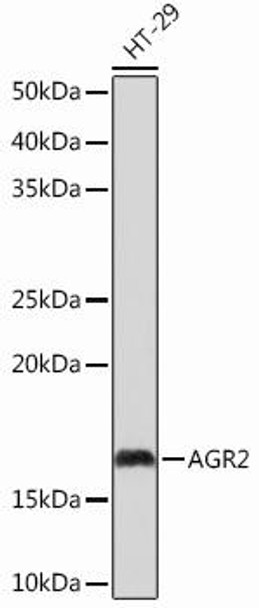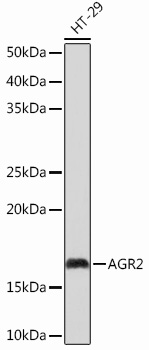Anti-AGR2 Antibody (CAB12411)
- SKU:
- CAB12411
- Product type:
- Antibody
- Reactivity:
- Human
- Mouse
- Rat
- Host Species:
- Rabbit
- Isotype:
- IgG
- Antibody Type:
- Monoclonal Antibody
- Research Area:
- Cell Biology
Frequently bought together:
Description
| Antibody Name: | Anti-AGR2 Antibody |
| Antibody SKU: | CAB12411 |
| Antibody Size: | 20uL, 50uL, 100uL |
| Application: | WB IF |
| Reactivity: | Human, Mouse, Rat |
| Host Species: | Rabbit |
| Immunogen: | A synthesized peptide derived from human AGR2 |
| Application: | WB IF |
| Recommended Dilution: | WB 1:500 - 1:2000 IF 1:50 - 1:200 |
| Reactivity: | Human, Mouse, Rat |
| Positive Samples: | Mouse testis, HT-29 |
| Immunogen: | A synthesized peptide derived from human AGR2 |
| Purification Method: | Affinity purification |
| Storage Buffer: | Store at -20°C. Avoid freeze / thaw cycles. Buffer: PBS with 0.02% sodium azide, 0.05% BSA, 50% glycerol, pH7.3. |
| Isotype: | IgG |
| Sequence: | Email for sequence |
| Gene ID: | 10551 |
| Uniprot: | O95994 |
| Cellular Location: | |
| Calculated MW: | 17kDa |
| Observed MW: | 18KDa |
| Synonyms: | AG-2, AG2, GOB-4, HAG-2, HEL-S-116, HPC8, PDIA17, XAG-2 |
| Background: | This gene encodes a member of the disulfide isomerase (PDI) family of endoplasmic reticulum (ER) proteins that catalyze protein folding and thiol-disulfide interchange reactions. The encoded protein has an N-terminal ER-signal sequence, a catalytically active thioredoxin domain, and a C-terminal ER-retention sequence. This protein plays a role in cell migration, cellular transformation and metastasis and is as a p53 inhibitor. As an ER-localized molecular chaperone, it plays a role in the folding, trafficking, and assembly of cysteine-rich transmembrane receptors and the cysteine-rich intestinal gylcoprotein mucin. This gene has been implicated in inflammatory bowel disease and cancer progression. [provided by RefSeq, Mar 2017] |
| UniProt Protein Function: | AGR2: Required for MUC2 post-transcriptional synthesis and secretion. May play a role in the production of mucus by intestinal cells. Proto-oncogene that may play a role in cell migration, cell differentiation and cell growth. Interacts with LYPD3 and DAG1 (alphaDAG1). Interacts with MUC2; disulfide-linked. Expressed strongly in trachea, lung, stomach, colon, prostate and small intestine. Expressed weakly in pituitary gland, salivary gland, mammary gland, bladder, appendix, ovary, fetal lung, uterus, pancreas, kidney, fetal kidney, testis, placenta, thyroid gland and in estrogen receptor (ER)-positive breast cancer cell lines. Belongs to the AGR family. |
| UniProt Protein Details: | Protein type:Secreted; Oncoprotein; Secreted, signal peptide Chromosomal Location of Human Ortholog: 7p21.3 Cellular Component: endoplasmic reticulum; extracellular space Molecular Function:epidermal growth factor receptor binding; protein binding; protein homodimerization activity Biological Process: digestive tract morphogenesis; positive regulation of developmental growth; positive regulation of epidermal growth factor receptor signaling pathway |
| UniProt Code: | O95994 |
| NCBI GenInfo Identifier: | 67462105 |
| NCBI Gene ID: | 10551 |
| NCBI Accession: | O95994.1 |
| UniProt Related Accession: | O95994 |
| Molecular Weight: | 19,979 Da |
| NCBI Full Name: | Anterior gradient protein 2 homolog |
| NCBI Synonym Full Names: | anterior gradient 2, protein disulphide isomerase family member |
| NCBI Official Symbol: | AGR2 |
| NCBI Official Synonym Symbols: | AG2; GOB-4; HAG-2; XAG-2; PDIA17; HEL-S-116 |
| NCBI Protein Information: | anterior gradient protein 2 homolog |
| UniProt Protein Name: | Anterior gradient protein 2 homolog |
| UniProt Synonym Protein Names: | HPC8; Secreted cement gland protein XAG-2 homolog |
| Protein Family: | Anterior gradient protein |
| UniProt Gene Name: | AGR2 |
| UniProt Entry Name: | AGR2_HUMAN |






